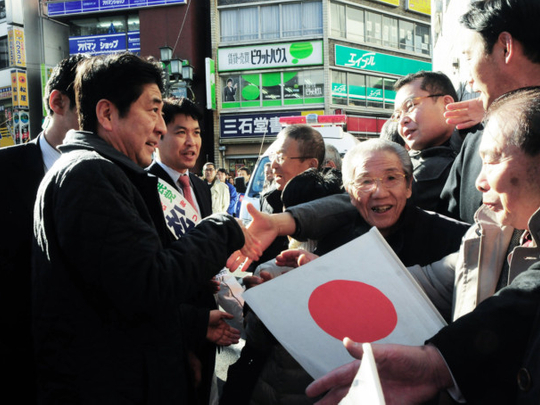
Two decades of sluggish growth had scarred Japan’s economic landscape. Deflation, a debt-to-gross domestic product (GDP) ratio in excess of 200 per cent, stagnant private spending and a lot of the formerly highly successful industry conglomerates accruing huge losses were the scenarios the country had to live with while a rapidly ageing society threatened to exacerbate the problem.
But then came Shinzo Abe, the leader of the Liberal Democratic Party, who took over as prime minister in a landslide election victory last December and changed the mood in the country.
The Nikkei 225 shot up nearly 20 per cent in the first quarter of this year, now sitting above 12,000 points. Appreciation of the yen eased, largely due to speculation on Abe’s new hand-picked team at the Bank of Japan printing fresh money. The weaker yen improved the conditions for the largely export-driven economy, and consumers turned bullish, with spending in the first two months of 2013 up 3 per cent over the same period last year, even though there has been scant evidence of rising wages and salaries.
Abe has introduced what economists call Abenomics, an aggressive compilation of monetary, fiscal and economic growth strategies that entail curbing inflation, correcting the strong yen, expanding public investment by 2 per cent of GDP in 2013 and, most of all, printing more money to pump it into the economy, a strategy known as quantitative easing.
All this sets high expectations and puts a lot of pressure on the Bank of Japan, whose team was changed by Abe — one of his first actions after taking office.
The conservative roadmap has triggered applause from outside. Among the first to comment was the Organisation for Economic Co-operation and Development (OECD), the club of rich nations including the US, UK, Germany and Australia.
Aiming for inflation
“The prospect of more aggressive easing, with the Bank of Japan’s adoption of a 2 per cent inflation target, has resulted in a 20 per cent depreciation of the yen in real effective terms and a surge in equity prices,” the Paris-based club said in its interim report on the outlook for the Group of Seven economies, released last month. “These [measures] have boosted the near-term growth and inflation outlook. This shift in stance and the effects of its announcement are welcome,” the report stated.
The OECD has also revised its growth outlook for Japan for the first quarter of 2013 to an annualised 3.2 per cent in a sharp upward revision from its November forecast of a 1.5 per cent rise.
However, the war on deflation in Japan is seen by economists as a huge monetary experiment that carries its risks. The Bank of Japan, at its first meeting on April 3 and 4 with the new chief banker Haruhiko Kuroda, who comes from the Asian Development Bank, introduced stimulus programmes out of the limited number of options it has to consolidate the country’s finances, including a foreign bond-buying programme and a directive to start buying longer-dated bonds, a cut in the interest rate the central bank pays on excess reserves, and has said it will step up purchases of risk assets such as exchange-traded funds.
In the meeting, Kuroda vowed to meet the inflation target within two years and to double money supply, which is a fundamental shift in how the central bank conducted monetary policy before.
However, in the longer term, structural reforms will have to be put in place, but this takes time to work, say critics.
“A structural reform would include that Japan becomes keener on free trade agreements but may start to dismantle its industrial protectionism,” Werner Clausen, a financial analyst affiliated with Deutsche Bank Asia-Pacific, tells GN Focus.
“Markets are certainly expecting a more radical transformation of the monetary policy than the Bank of Japan is capable of delivering at the moment. Japan also needs to be careful not to fall back on its nationalistic agenda,” he adds. In fact, the government in Tokyo has not been very active in opening its protected industries in the past, even in the wake of the crisis. Though there has been movement in some areas as the cabinet recently approved a plan to open up the country’s power sector to more competition, much more needs to be done to lure foreign investment into the country and balance trade with the outside world.
Abe has now entered talks on the Trans-Pacific-Partnership (TPP), a new economic pact between American and Asia-Pacific nations pushed strongly by US president Barack Obama and dubbed by him as “an economic cooperation of the 21st century”, and seen by others as the de-westernisation of globalisation.
Change in direction
However, fully joining the TPP would entail an opening up of the Japanese markets and allowing access to highly isolated sectors such as agriculture, the car industry and the financial service industry. Japan would also have to reduce trade tariffs, which could have another negative impact on public finances. It would also require major changes in intellectual property rights policy, would raise issues of food security as the government would have to change the income compensation programme for farmers and the mode of land transactions, and would probably also lead to massive immigration of unskilled foreign workers.
However, the decision to push joining the TPP marks a major milestone for Japan. It can be a catalyst for the structural reforms the country so badly needs to raise productivity and growth in the face of a declining workforce. Japan’s urban consumers may no longer need to pay eight times the world price for rice to protect a dwindling farm population. The opening of the market and strengthened rules under a TPP agreement could give Japanese exporters new opportunities in growing Asia-Pacific markets. Estimates say TPP entry could raise Japanese GDP by 0.5 per cent per annum. The country has now really arrived at a critical juncture.






